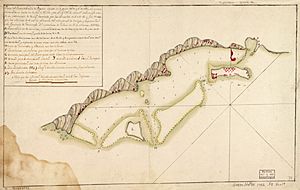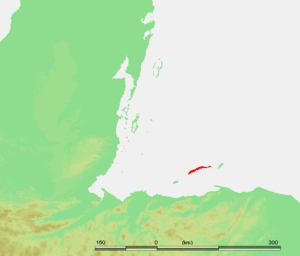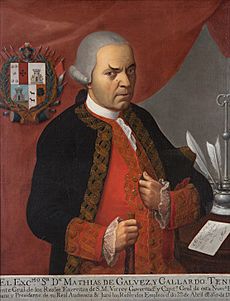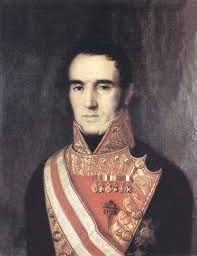Battle of Roatán facts for kids
Quick facts for kids Battle of Roatán |
|||||||
|---|---|---|---|---|---|---|---|
| Part of the American Revolutionary War | |||||||
 A 1782 Spanish map of Roatán. New Port Royal is visible on the right side of the island. |
|||||||
|
|||||||
| Belligerents | |||||||
| Commanders and leaders | |||||||
| Edward Marcus Despard | Matías de Gálvez Gabriel Herbias Enrique MacDonell |
||||||
| Strength | |||||||
| 81+ regulars | 600 regulars 3 frigates |
||||||
| Casualties and losses | |||||||
| 2 wounded 81 captured |
2 killed 4 wounded |
||||||
The Battle of Roatán was a fight that happened on March 16, 1782. It was part of the American Revolutionary War. British and Spanish forces fought for control of Roatán, an island off the coast of what is now Honduras.
A Spanish army led by Matías de Gálvez, who was the leader of Spanish Guatemala, took control of the island. They did this after attacking its main defenses with cannons. The British soldiers on the island gave up the next day. The Spanish then moved the captured soldiers, 135 civilians, and 300 enslaved people off the island. They also destroyed the British settlement, saying it was used by pirates and privateers.
This attack was part of a bigger plan by Gálvez to reduce British power in Central America. Even though he had some success, the British managed to keep a presence in the area.
Why They Fought: The Background
When Spain joined the American Revolutionary War in 1779, both Spain and Great Britain wanted control over lands in Central America. Most of this land was claimed by Spanish Guatemala. However, the British had set up logging areas on the southern coast of the Yucatan Peninsula (which is now Belize). They also had settlements on the Mosquito Coast.
The Spanish Governor, Matías de Gálvez, quickly took action when war was declared. He captured St. George's Caye, a main British island settlement near the Yucatan coast. Many British people who lived there then went to Roatán. Roatán was another British-controlled island, about 40 miles (64 km) off the Honduran coast.

A British commander named Edward Marcus Despard used Roatán as a base. From here, he led small attacks to keep British influence strong on the Mosquito Coast. He also used it for privateering, which meant attacking Spanish ships.
King Charles of Spain told Gálvez to "remove the English from their hidden settlements." So, Gálvez started planning attacks against the British settlements as early as 1780. He gathered about 15,000 local soldiers and received help from other Spanish colonies. The attacks didn't start until after the American victory at Yorktown in October 1781. This victory meant the British might send more troops to Central America.
Gálvez planned to attack the British in the Bay Islands (especially Roatán) first. Then, he would clear the British from the mainland coast. In early 1782, troops from central Guatemala gathered at Trujillo for the Roatán attack. Other forces moved by land from Nicaragua, Honduras, and Salvador towards the main British settlement of Black River.
Gálvez arrived at Trujillo on March 8 to get ready for the attack on Roatán. He left 600 soldiers at Trujillo to keep bothering the British. He then took another 600 troops on ships and sailed for Roatán on March 12. Three large Spanish warships (the Santa Matilde, Santa Cecilia, and Antiope) and smaller armed ships went with them. Commodore Enrique MacDonell was in charge of these ships.
The British people living on Roatán knew the Spanish were planning something. The main settlement, New Port Royal, had two forts called Dalling and Despard. These forts had 20 cannons. However, there were not many white non-enslaved people on the island. In 1781, they asked for help from the British commander at Bluefields, Nicaragua. He could only send more weapons, which didn't make the island much safer.
The Battle Begins

The Spanish ships arrived near Roatán at 6:00 AM on March 13. The British defenders fired some cannon shots, but they didn't hit anything. The Spanish ships then anchored out of range. At 8:00 AM, Gálvez sent his second-in-command, Enrique MacDonell, to ask the British to surrender. MacDonell spoke English.
The British asked for six hours to think about it, and Gálvez agreed. After that time, MacDonell returned with their answer: the British refused to surrender. They said they were ready to fight "to the death." The Spanish were not surprised, as their sailors had seen the British getting their defenses ready during the waiting period.
An immediate attack wasn't possible because of strong winds and rough seas. So, Gálvez held a meeting with his 11 officers, and they made a plan for the attack.
Around 10:15 AM on March 16, the Spanish cannons began firing at Forts Dalling and Despard. These forts protected the entrance to New Port Royal's harbor. By 1:00 PM, the British cannons in the forts had stopped firing. Major General Gabriel Herbias then started landing Spanish troops. After the two forts were taken, the Spanish warships entered the harbor. They began firing cannons at the town. British cannons in the hills above the town fired back. This exchange of fire continued until sunset. At that point, the British defenders gave up. The Spanish had two soldiers killed and four wounded in the battle. Only two enslaved people were wounded on the British side.
What Happened Next
The terms of surrender were agreed upon the next day. Gálvez and his men stayed on the island for several days. They collected weapons, gathered enslaved people who had run away, and destroyed all the buildings and farms on the island. They also burned many ships in the harbor, believing they were used for illegal trade.
The Spanish left the island on March 23. They took 81 British soldiers, 300 enslaved people, and 135 British civilians as prisoners. The prisoners were sent to Havana, Cuba. There, the enslaved people were sold, and the others were held until they could be exchanged for Spanish prisoners.
Gálvez was only able to temporarily reduce British influence in the area. After his success at Roatán, he captured Black River in early April. However, his efforts to advance further lost momentum. James Lawrie, the British commander at Black River, and Edward Marcus Despard successfully took Black River back. They held it until the end of the war.
See also
 In Spanish: Batalla de Roatán para niños
In Spanish: Batalla de Roatán para niños


